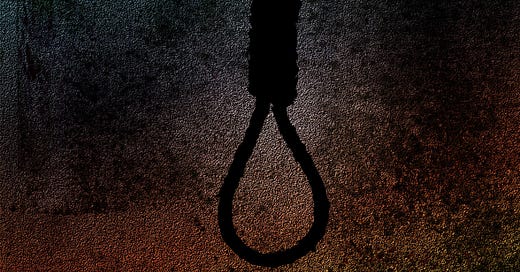We might have just glimpsed the rope that Donald Trump will hang himself with, and it could be delivered by irate retirees. The tariff war Trump has started already has financial markets spooked, because investors fear nothing more than uncertainty. Donald Trump is a Chernobyl of uncertainty.
Stocks fell sharply this morning, the first trading day since the tariffs were announced. The S&P was down 2% at one point, though by afternoon had bounced back, partly on news that the U.S. and Mexico would postpone their tariffs for a month. Short-term movements tell you little about what will happen longer term, or even tomorrow, but a protracted trade war, or just fear of one, could mean further declines.
The thing to know about market outcomes is that they’re often self-fulfilling. If you can convince a critical mass of investors that something is about to happen, they will behave in ways that make it happen. This works on the way up as well as on the way down, and largely because of something called “herd behavior.”
Start bailing
The investing herd piled into dotcom stocks in the late ‘90s on the self-fulfilling premise, reinforced by countless “new economy” evangelists (hilariously pilloried in Thomas Frank’s “One Market Under God”), that prices would always rise. They did the same with houses a few years later. In both cases, after enough headlines about the “bubble economy” and unsustainable prices, the herd bailed as soon as the hive-mind of the market concluded that the party was over.
There is a name for this balance-tipping realization: the Minsky moment — after Washington University economist Hyman Minsky, whose “financial instability hypothesis” argued that financial markets tend naturally toward booms and busts, which is one reason you need prudential market regulation. (The New Yorker’s John Cassidy offers a useful chapter on Minsky in his 2009 book “How Markets Fail: The Logic of Economic Calamities,” which I’m on the record for praising as one of the best explanations yet for what happened in 2008-09).
In a typical cycle, rising asset prices induce an influx of often naïve, easily spooked small investors as well as large, systemically important, risk-prone institutions, many of whom borrow heavily to finance their holdings. At some point during the inexorable rise in prices they begin to sense a ceiling and start eyeing the exits. The ensuing environment of risk aversion serves as kindling for the inevitable panic. The spark is some sort of shock — rumors of a major default, a surprise hike in interest rates, a political crisis.
Donald Trump’s reckless tariffs may be that shock, though it will take time to know for sure. It’s clear, however, that the market looks primed for Minsky.
What Warren says
Thanks partly to the “Trump trade” — the belief, again self-fulfilling, that Trump policies will fuel a market rally — stock prices are historically high by widely consulted measures. The current price/earnings ratio for the S&P Index, which your 401(k) likely tracks, is 30, about twice the median since 1870 (but not the stratospheric levels reached during the dotcom mania). The Buffett ratio, after Warren, measures overall stock values as a percentage of total economic output. It’s also flashing bubble, as is a more obscure but perhaps more important indicator, “short interest.” That one measures the level of “short-selling,” a way of profiting by anticipating market declines. Even the Great Vampire Squid is reportedly concerned about that metric.
The S&P itself is barely below its all-time high. Its “total return” (which includes reinvested dividends) has risen an average of 13.3% for the past five years, well above its historical average of around 10%. So the last thing investors need right now is a reason to panic — which, of course, Trump has delivered with exquisite timing.
Yet a panic might also reveal a light at the far end of the MAGA tunnel. Trump voters who are willing to overlook, and even applaud, his every transgression may draw the line at watching their 401(k) balances plunge. Culture wars and out-of-control borders are distant abstractions for most, but the S&P can hit everyone where it counts. So could the higher prices that economists say a trade war would produce, at least in the short term.
A severe recession, which often follows a market crash, could further curdle public sentiment toward Trump and, as important, Trumpism. Throw in a collapse of the digital tulip bulbs we call crypto-currencies — another Trump grift/fetish — and who knows where things could go.
As a trust-fund baby who’s never had to worry about where his next paycheck was coming from, Trump likely has scant appreciation for what bear markets, inflation or recession mean to the average American. But voters know exactly what they mean. If they come to associate Trump with “crash” and “inflation” the way Kamala is tied to “they/them,” the market may do in 2028 what the Democrats couldn’t in 2024.
Note to Wall Street: We thank you in advance.




